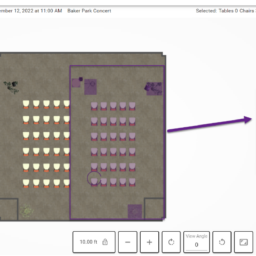In the world of event planning, nothing is set in stone. Despite meticulous planning, unexpected changes in event size can throw even the most seasoned planners off balance. It is crucial to know how to manage these changes effectively, whether it’s an unexpected surge in attendees or a sudden drop. Today, we’ll explore strategies like a pro to handle fluctuating event sizes.
The Reality of Event Planning
Event planning is a dynamic field. One minute, everything is proceeding as planned; the next, you’re grappling with unexpected challenges. The ability to handle changes in event size is not just a skill but a necessity for event planners and venue owners. This guide will arm you with practical strategies to manage these changes seamlessly.
Understanding the Causes of Changes
Changes in event size can stem from various factors. Last-minute cancellations, new registrations, or unforeseen circumstances can all play a role. Recognizing these factors helps anticipate potential changes and prepare accordingly.
The Importance of Flexibility
Flexibility is the backbone of successful event management. Adopting a flexible approach allows planners to adapt to changes swiftly. This means having contingency plans and being ready to pivot when necessary.
Adopting a Mindset of Adaptability
An adaptable mindset is essential. Instead of viewing changes as setbacks, see them as opportunities to showcase your problem-solving abilities. This positive outlook can significantly improve your handling of unexpected situations.
Training Your Team
Your team’s ability to adapt is just as important as yours. Regular training sessions focusing on flexibility and problem-solving can equip your team to handle changes efficiently.
Leveraging Technology
Technology can be a game-changer. Tools like event management software can help you track registrations in real time, making it easier to adjust plans.
Communicating with Stakeholders
Transparent communication with stakeholders is vital. Keeping sponsors, vendors, and attendees informed about changes ensures everyone is on the same page and can adjust their plans accordingly.
Early and Frequent Updates
Regular updates are crucial. Inform stakeholders of potential changes as early as possible and provide frequent updates as the situation evolves.
Using Multiple Channels
Use various communication channels, such as emails, social media, and your event website, to ensure your message reaches everyone.
Setting Clear Expectations
Clearly outline what changes are happening and how they will affect stakeholders. Clear instructions help minimize confusion and ensure smooth transitions.
Adjusting Venue Arrangements
Venue arrangements, including seating plans, catering, and logistical setups, often need to be adjusted when the event size changes.
Reconfiguring Seating Plans
Work closely with the venue to reconfigure seating arrangements. Whether you need more seats or fewer, having a flexible seating plan can accommodate sudden changes.
Coordinating with Caterers
Notify caterers promptly about changes in attendee numbers. This helps adjust food and beverage quantities, reduce wastage, and ensure there’s enough for everyone.
Modifying Logistical Setups
Logistics play a crucial role in an event’s success. Adjust plans involving entry and exit points, registration desks, and other logistical elements to suit the new event size.
Managing Budget Implications
Changes in event size can have significant budget implications. It’s essential to review and adjust your budget to reflect these changes.
Reevaluating Costs
Reevaluate costs associated with the event size change. This includes venue charges, catering expenses, and any additional logistics.
Negotiating with Vendors
Negotiate with vendors for contract flexibility. If communicated promptly, many vendors are willing to accommodate changes without additional charges.
Allocating Resources Effectively
Reallocate resources based on the new event size. Ensure critical areas receive the necessary funding to maintain the event’s quality.
Ensuring Guest Experience
Despite the changes, maintaining a positive guest experience is paramount. Your attendees’ satisfaction should remain a top priority.
Personalized Communication
Send personalized messages to attendees explaining the changes and how you’re addressing them. This effort shows that you value their participation.
Enhancing Engagement
Enhance engagement through interactive sessions, personalized content, or unique experiences to make attendees feel valued despite the size change.
Feedback Mechanisms
Implement feedback mechanisms to gauge attendee satisfaction. Use this feedback to improve future events and demonstrate your commitment to continuous improvement.
Utilizing Data and Analytics
Data and analytics can provide valuable insights into managing event size changes. Leveraging these tools can help you make informed decisions.
Tracking Registration Trends
Use analytics to track registration trends and predict potential changes. This foresight allows for proactive adjustments.
Analyzing Attendee Behavior
Analyze attendee behavior to understand their preferences. This information can guide adjustments in event planning to meet attendees’ needs better.
Evaluating Event Impact
Post-event analytics can evaluate the impact of size changes on the event’s success. This data can be used to better plan future events.
Learning from Experience
Every event provides learning opportunities. Analyze what worked and what didn’t to build a stronger foundation for future events.
Conducting Post-Event Reviews
Conduct thorough post-event reviews with your team. Identify areas of improvement and successes to refine your strategies.
Documenting Lessons Learned
Keep a documented record of lessons learned from each event. This resource can serve as a valuable reference for future planning.
Continuous Improvement
Adopt a mindset of continuous improvement. Strive to enhance your skills and processes with every event you manage.
Building a Resilient Event Planning Strategy
A resilient event planning strategy involves preparation, adaptation, and continuous learning. A robust strategy ensures you can handle any changes with confidence.
Developing Contingency Plans
Develop comprehensive contingency plans for various scenarios. These plans provide a clear roadmap during unexpected changes.
Investing in Training
Invest in regular training for yourself and your team. Staying updated with industry trends and best practices enhances your preparedness.
Fostering a Positive Culture
Foster a positive culture within your team. Encourage open communication, collaboration, and a proactive approach to problem-solving.
Conclusion
Wrapping up, handling changes in event size requires a blend of flexibility, communication, and strategic planning. By adopting these strategies, event planners and venue owners can turn challenges into opportunities, ensuring every event succeeds. Remember, the ability to adapt and thrive in the face of unexpected changes sets great event planners apart.














